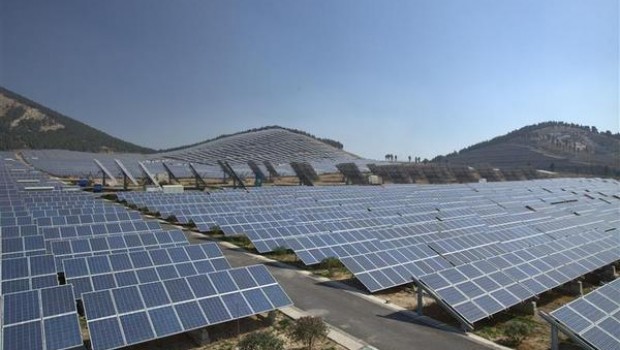The battle to go 100% renewable at Lima – are we winning the carbon war?

Environmentalist and entrepreneur Jeremy Leggett argues that, after a quarter century as a campaigner feeling like we were losing the carbon war, we have begun the process of winning.
In this extract from his new book he and Steve Sawyer bat for the solar and wind industries at the Lima Climate Summit on a 100% renewables target for Paris.
“Something huge is happening this week”. So reads an e-mail from the online activist group Avaaz to its 40 million members. In Lima, governments are about to set a goal to cut carbon pollution completely. But it is at risk. The e-mail appeals to Avaaz members to get busy signing one of their multi-million-signature international e-petitions.
Young digital campaigners are not alone in exhorting action. A group of Catholic bishops, spanning every continent, publishes a demand for an end to use of fossil fuels. Their statement calls for 100% renewable energy, and a strong focus on finance for adaptation.
Today the Lima summit will witness an all-too rare fighting alliance among the renewables industries, in support of the 100% target. The Global Wind Energy Council gives a joint press conference with the European Photovoltaic Industry Association. Steve Sawyer and I, representing the two trade bodies, have the mission of sending a signal to negotiators that they can be confident of a target of total decarbonisation in the energy sector by 2050. It is the second week of the talks. Ministers have arrived at the summit. Now is the time to state our case loud and clear.
In the UN media centre, Steve Sawyer opens with the thought that negotiators are generally 10 to 15 years out of date in their thinking on renewables. I profess that a 100% renewable-energy future is feasible far sooner than most negotiators at these climate talks appreciate, and certainly well before 2050.
Sawyer attributes much of the technical ability to reach 100% renewables to advances in the solar industry. Five years ago, he notes, I would, and did say, the majority of renewables would come from hydro and wind power. But with the dramatic up-take in the solar industry in the last five years, and the cost reductions in that period of time, solar is already making a substantial contribution and rising faster than anyone thought possible.
I spell out the key facts: that solar prices have fallen by two-thirds in six years, and according to the International Energy Agency, prices will come down another two thirds by 2050.
Elsewhere in the world, our enemies counter attack. Wind and solar are “just not ready for prime time”, Exxon’s chief strategist Bill Colton tells journalists. The two technologies will only be providing 4% of the world’s energy by 2040. Carbon fuels will still be providing the great majority.
Harlan Watson, former lead US climate negotiator in the Bush years, and now a carbon-fuel lobbyist, echoes this here in Lima. “I don’t think you could get from here to there in development terms just with renewables. They’re still very expensive and intermittent,” he tells the press.
In Germany, at around noon on the day of our press conference, 29 gigawatts of wind power and 5 gigawatts of solar provide 46% of the nation’s electricity.
In the afternoon, a call from the special advisor to the UK Secretary of State for Energy and Climate Change, Ed Davey. Davey, head of the British government delegation in Lima, is looking for a story to hit the UK press back home, where he has so far found it difficult to attract attention.
He is thinking of doing a speech on the carbon bubble that evening, at an event at the British Ambassador’s residence. The Spad, as special advisors are known, wants my opinion. He is very specific. What can possibly go wrong if the Secretary of State majors on this?
That is code for will Carbon Tracker support him.
I can’t think of anything, I respond. Rather, he would surely look statesmanlike on a cutting-edge issue.
Thank you, says the Spad. Your invitation to the event will be in your e-mail in-box in just a minute.
I take a taxi to the residence, in the hills above the city. It is a modern mini-palace. I drink champagne and chat with luminaries of the Peruvian business community and their wives. Ed Davey sits in a corner of the luxuriant garden, surrounded by the entire British media corps – more than a dozen of them. They are all scribbling in notebooks.
Later he gives his speech. The theme is “from carbon capitalism to climate capitalism”. It is one of those titles you wish you had thought of yourself. The content is all about the carbon bubble. Carbon Tracker is the only organisation he name checks other than the Bank of England.
The Secretary of State tells his audience that he has written to the Governor of the Bank of England asking him two things, essentially. First, what will the Bank be doing, during the course of its investigation of the threat that the carbon-fuel industries might pose to the global financial system, to safeguard British pensioners’ investments? Second, what will the Bank be doing to engage other regulators around the world in its enquiry?
The Secretary of State does not leave in the balance the question of whether or not risk exists, the way the Bank carefully does when talking about the enquiry. He clearly assumes that it does.
Jeremy Leggett is penning a serialised book called The Winning of the Carbon War, downloadable free on the first of every month through to the end of the Paris climate summit. The latest version, up to date through April 20th, is downloadable here.

